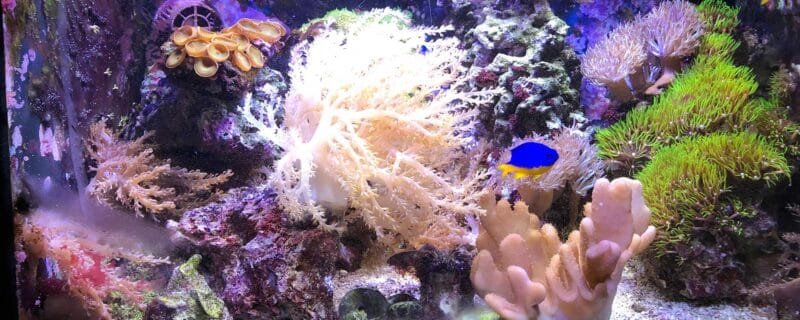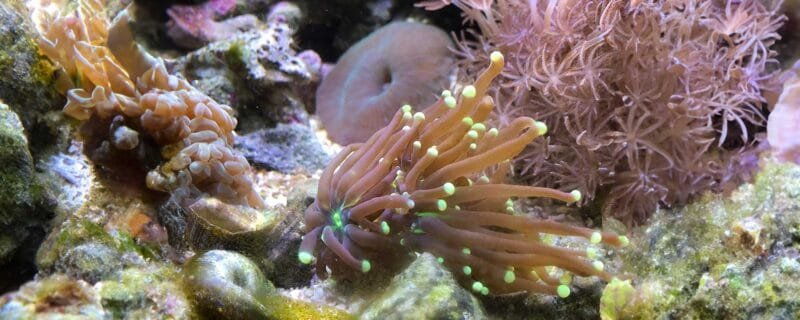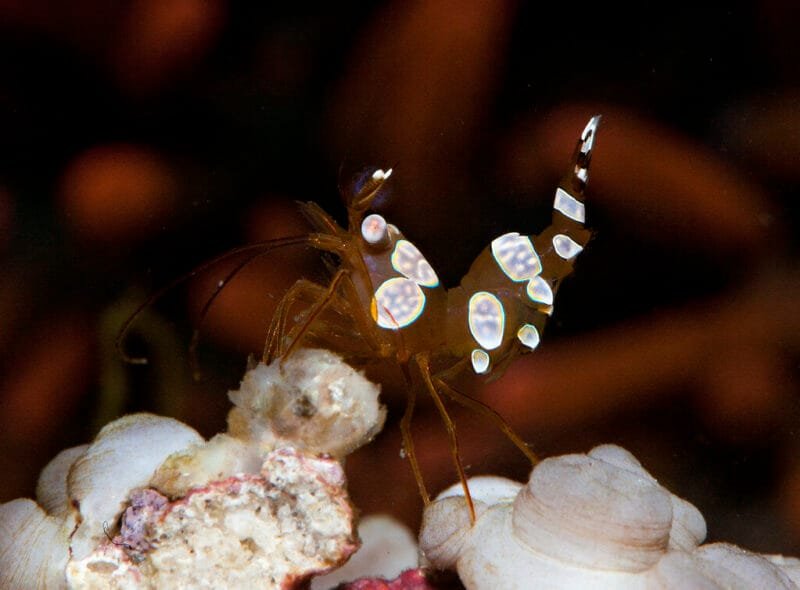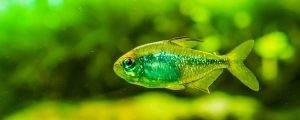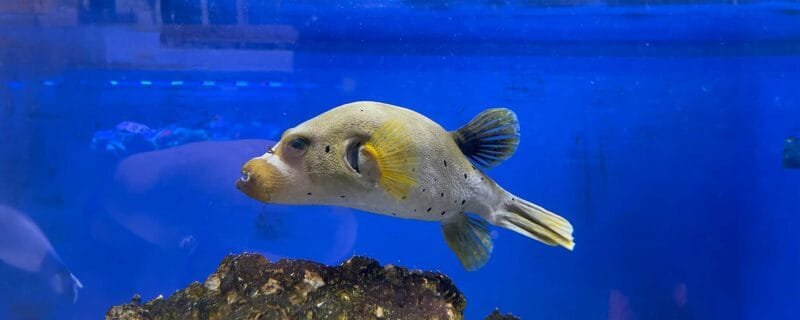The Barber Pole Shrimp (Stenopus hispidus), also commonly known as the Banded Coral Shrimp or Coral Banded Shrimp, is one of the most recognizable and beloved invertebrates in the marine aquarium hobby. With its vivid red and white “barber pole” coloration and graceful, long white antennae, this shrimp adds both color and character to saltwater tanks. But beyond its beauty, the Barber Pole Shrimp is renowned for its unique cleaning behavior—removing parasites and dead tissue from fish that willingly visit its “cleaning stations.”
Native Habitat
The Barber Pole Shrimp is native to tropical and subtropical reefs around the world. Its distribution spans the Indo-Pacific region, the Red Sea, the Caribbean Sea, and the western Atlantic Ocean. In the wild, it typically inhabits coral crevices, reef slopes, and ledges, where it establishes cleaning stations for passing fish.
Appearance and Size
The Barber Pole Shrimp is aptly named for its bold red-and-white banded body, reminiscent of a traditional barber’s pole. Its claws are tipped in blue, and its antennae are long, white, and sweeping, often extending several inches beyond its body.
-
Average Size: 2 to 3 inches (5 to 7.5 cm) in body length
-
Leg Span: Up to 4 inches (10 cm) with antennae extending even farther
-
Lifespan: 2 to 3 years in captivity under optimal care
Its striking coloration and delicate movement make it a showpiece in any marine aquarium.
Diet
Barber Pole Shrimp are omnivorous scavengers and natural cleaners. In the wild, they feed on parasites, dead tissue, and leftover food from fish. In aquariums, they will accept:
-
Mysis shrimp
-
Brine shrimp
-
Marine pellets and flakes
-
Chopped seafood (fish or shrimp pieces)
-
Frozen marine blends
They will also scavenge uneaten food from the substrate, helping maintain tank cleanliness. Feeding them 3–4 times a week with small portions ensures they remain active and healthy.
Sexing
Sexing Stenopus hispidus is relatively difficult because the species is sexually monomorphic—males and females appear nearly identical. However:
-
Females are usually slightly larger with broader abdomens.
-
Males may have narrower abdomens and slimmer claws.
A bonded male-female pair will often share the same crevice or rock shelter, which can be an indicator of pairing behavior.
Breeding
Breeding Barber Pole Shrimp in captivity is challenging but possible. The species forms monogamous pairs, and once bonded, they remain together for life.
-
Courtship: Involves cleaning rituals and gentle antennae contact.
-
Egg Development: Females carry eggs under their abdomens for several weeks.
-
Larvae: Once released, larvae are planktonic and drift in the water column.
Because the larvae have a long planktonic stage, rearing them in captivity requires specialized rearing tanks and microplankton feeding, making successful breeding rare for hobbyists.
Reef Safe and Community Compatibility
The Barber Pole Shrimp is reef safe, meaning it does not harm corals or anemones. However, its temperament can vary:
-
Compatible With:
-
Peaceful reef fish (clownfish, gobies, tangs, etc.)
-
Non-aggressive invertebrates (snails, hermit crabs)
-
Other cleaner shrimp species only in very large tanks
-
-
Not Compatible With:
-
Other Barber Pole Shrimp (they are territorial toward their own kind)
-
Aggressive predators such as triggers, hawkfish, or large wrasses
-
A single pair is ideal for a moderate-sized reef tank (40 gallons or more).
Water Conditions
To thrive, Barber Pole Shrimp require stable, pristine marine conditions:
| Parameter | Ideal Range |
|---|---|
| Temperature: | 72–80°F (22–27°C) |
| pH: | 8.1–8.4 |
| Salinity: | 1.023–1.025 (specific gravity) |
| Ammonia/Nitrite: | 0 ppm |
| Nitrate: | <20 ppm |
| Calcium: | 400–450 ppm |
| KH (Alkalinity): | 8–12 dKH |
A well-established, cycled tank with live rock and minimal fluctuations ensures long-term health and coloration.
Ease of Care
Barber Pole Shrimp are considered moderately easy to care for. While they adapt well to captive life, they require stable parameters, no copper exposure, and peaceful tank mates. Copper-based medications are lethal to all crustaceans and should never be used in tanks housing them.
They also molt regularly as they grow. During this vulnerable period, they hide for several days until their new exoskeleton hardens. Ensure plenty of rockwork and caves for shelter during these times.
Tank Mates
The Barber Pole Shrimp pairs well with many reef-friendly fish species:
Avoid housing them with aggressive fish or large predatory crustaceans. A peaceful community tank allows them to establish their cleaning station and display natural behaviors.
Species Variations
While Stenopus hispidus is the most recognized, there are several closely related species in the Stenopus genus:
-
Golden Coral Banded Shrimp (Stenopus zanzibaricus) – Yellow and white bands instead of red and white.
-
Blue Banded Coral Shrimp (Stenopus tenuirostris) – Blue bands on the body and legs.
-
Marble Banded Shrimp (Stenopus pyrsonotus) – Reddish-marble body with a dark stripe along the back.
Each variation has similar care requirements but slightly different appearances, adding diversity for advanced aquarists.
The Albino Version
An Albino Barber Pole Shrimp is a rare and stunning variation where the red pigment is replaced with pale pink or translucent white. While not common in the wild, albino variants may appear through selective breeding or genetic mutation.
Albino individuals require identical care conditions but may be more sensitive to light and environmental stressors. Their ghostly white coloration makes them a unique centerpiece in reef displays.
FAQs
1. Can I keep more than one Barber Pole Shrimp in the same tank?
Only if they are a mated pair. Otherwise, they will become territorial and fight, often resulting in injury or death.
2. Do they really clean fish?
Yes. In both the wild and aquariums, they are true cleaner shrimp, removing parasites and dead tissue from cooperative fish species.
3. How often do they molt, and is that dangerous?
Molting frequency depends on age and diet. Young shrimp may molt every few weeks; adults every few months. Molting is natural but stressful—ensure they have hiding spots during this period to avoid predation.
Conclusion
The Barber Pole Shrimp (Stenopus hispidus) is a vibrant, functional, and fascinating addition to a saltwater aquarium. Beyond their eye-catching red and white stripes, these shrimp serve a vital ecological role as natural cleaners. With proper care, stable water conditions, and a peaceful environment, they can thrive and bring dynamic life to any reef tank.
Their combination of beauty, behavior, and symbiotic relationships makes them one of the ocean’s most charming invertebrates—a living symbol of balance and cooperation in the reef ecosystem.

